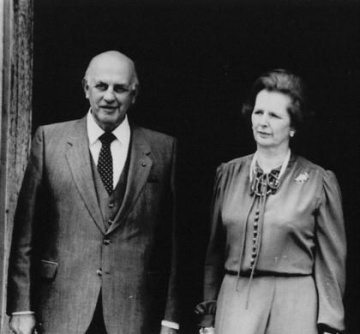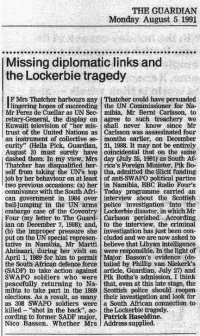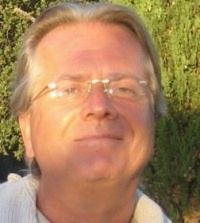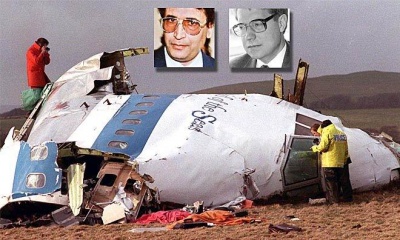Bernt Carlsson
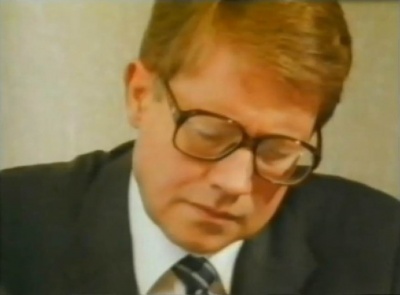
Bernt Wilmar Carlsson (21 November 1938 - 21 December 1988) was Assistant-Secretary-General of the United Nations and UN Commissioner for Namibia from July 1987 until he died on Pan Am Flight 103, which was sabotaged over Lockerbie, Scotland on Wednesday, 21 December 1988. All 259 passengers and crew on the flight were killed as well as eleven people in the town of Lockerbie. Newspaper reports quickly identified Bernt Carlsson as the highest profile victim.
According to these reports, Bernt Carlsson was on his way to New York to attend the signing ceremony on 22 December 1988 at United Nations headquarters of an agreement granting independence to Namibia, which had been illegally occupied by apartheid South Africa for over twenty years. Following the UN Commissioner's death at Lockerbie, South African foreign minister Pik Botha went ahead and signed the agreement. However, instead of handing control of Namibia to the United Nations, Pik Botha put the apartheid regime's Administrator-General, Louis Pienaar, in charge.
No investigation by the Scottish Police, the CIA, the FBI or the United Nations has ever been conducted into this compelling circumstantial evidence of the targeting of Bernt Carlsson on Pan Am Flight 103,[1] despite the branding of apartheid South Africa as a "terrorist state" during the 1988 US presidential election campaign.[2]
Contents
Highest profile Pan Am Flight 103 victim
Newspaper reports quickly identified Bernt Carlsson as the highest profile Pan Am Flight 103 victim.
The New York Times
The New York Times of Thursday, 22 December 1988 reported:
- U.N. Officer on Flight 103
- "Bernt Carlsson, who was a passenger on the Pan Am flight that crashed over Scotland, had served as chief administrative officer of the United Nations Council for Namibia since July 1987. He was on his way here for a ceremony on Thursday, at which accords providing for Namibia's independence are to be signed by Angola, Cuba and South Africa. The officer is, in theory, the United Nations' appointed governor for Namibia, the South African-ruled territory also known as South-West Africa. But because United Nations authority over Namibia is not recognised by South Africa, he is in practice the chief United Nations officer in charge of development programs intended to prepare Namibia for independence.
- "Mr Carlsson, a 51-year-old Swedish diplomat, had been in London for a meeting with non-governmental groups, United Nations officials said. He telephoned his office from the boarding gate at Heathrow Airport before the flight to New York.
- "From 1983 to 1985 Mr Carlsson served as a Swedish Ambassador at Large to the Middle East. He was General Secretary of the Socialist International, the world federation of socialist and social democratic parties, from 1976 to 1983. From 1983 to 1985, he was an Ambassador at Large and special emissary of Prime Minister Olof Palme to the Middle East and Africa. He also served as international secretary of the Swedish Social Democratic Party and as Under Secretary of State for Nordic Affairs in the Swedish Foreign Ministry."[3]
The Guardian
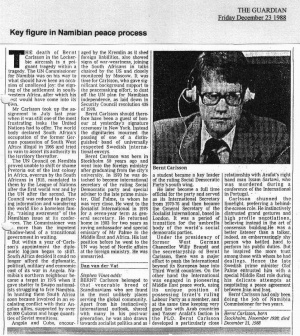
Bernt Carlsson's Obituary appeared in The Guardian of 23 December 1988:[4]
- Key figure in Namibian peace process
- "The death of Bernt Carlsson in the Lockerbie aircrash is a poignant tragedy within a tragedy. The UN Commissioner for Namibia was on his way to what should have been an occasion of unalloyed joy: the signing of the settlement in south-western Africa, after which his post would have come into its own.
- "Mr Carlsson took up the assignment in July last year when it was still one of the most frustrating tasks the United Nations had to offer. The world body declared South Africa’s occupation of the former German possession of South West Africa illegal in 1966 and tried in vain to assert its authority in the territory thereafter.
- "The UN Council on Namibia proved unable to shift or shame Pretoria out of the last colony in Africa, overrun by the South Africans in 1915, mandated to them by the League of Nations after the first world war and by the UN after the second. The Council was reduced to gathering information and wandering the world like a homeless family, "raising awareness" of the Namibian issue at its conferences. The Commissioner was no more than the impotent shadow-head of a transitional government in waiting.
- "But within a year of Carlsson’s appointment the diplomatic log-jam began to shift. South Africa decided it could no longer afford the diplomatic, political, military and economic cost of its war in Angola. Namibia’s northern neighbour became a target in 1975 when it gave shelter to Swapo nationalists struggling to free Namibia. In hunting them South Africa soon became involved in an escalating conflict with their Angolan allies, supported by over 50,000 Cubans and huge quantities of Soviet munitions.
- "Angola and Cuba, encouraged by the Kremlin as it shed foreign liabilities, also showed signs of war-weariness, joining the South Africans in talks chaired by the US and closely monitored by Moscow. It was time for Carlsson, who gave significant background support to the peacemaking effort, to dust off the UN plan for Namibian independence, as laid down in Security Council resolution 435 of 1978.
- "Bernt Carlsson should therefore have been a guest of honour at yesterday’s signature ceremony in New York. Instead the dignitaries mourned the passing of one of a distinguished band of universally respected Swedish international envoys.
- "Bernt Carlsson was born in Stockholm 50 years ago and went into the foreign ministry after graduating from the city’s university. In 1970 he was detached to become international secretary of the ruling Social Democratic party and special adviser to the late prime minister, Olof Palme, to whom he was very close. He went to the Socialist International in 1976 for a seven-year term as general secretary. He returned home in 1983 for two years as roving ambassador and special emissary of Mr Palme to the Middle East and Africa. His last position before he went to the UN was head of Nordic affairs at the foreign ministry. He was unmarried." (by Dan van der Vat)
Los Angeles Times
An Obituary to Bernt Carlsson, written by his friend Michael Harrington, was published in the Los Angeles Times on 26 December 1988.[5]
- Lost On Flight 103: A Hero To The Wretched Of The World
- "It was not an accident that my friend Bernt Carlsson, the UN Commissioner for Namibia, was killed in the crash of Pan American World Airways Flight 103.
- "Of course, it was a cruel and capricious fate that struck at Carlsson and his fellow passengers. But in Bernt's case it was part of a pattern - the kind of thing that might happen to a man who had spent his life ranging the Earth in search of justice and peace. And that life itself was emblematic of a Swedish socialist movement that has made solidarity with the wretched of the world a personal ethic.
- "Carlsson was returning home to New York for the signing of the agreement on Namibian independence, the culmination of his most recent mission. Before that he was a roving ambassador. From 1976 to 1983 he had been the general secretary of the Socialist International when that organisation was reaching out to the Third World as never before.
- "There had been so many flights, so many trips to the dangerous places like the Middle East and the front-line states of Southern Africa - even a brush with terrorism when Issam Sartawi, a Palestinian moderate, was murdered in the lobby of the Portuguese hotel at which the International was holding its congress in 1983. It was not inevitable that Carlsson be on a plane that, some suspect, was the target of fanatics, but it was not surprising - not the least because he came from a movement that made peace-making a way of life.
- "I sometimes think that if these Swedish men and women did not exist, the world would have to invent them. So it was that the United Nations gave Carlsson's mentor, the late Olof Palme, the impossible task of negotiating an end to the Iran-Iraq War. And why, as I saw firsthand at a meeting in Botswana, the Swedish prime minister was deeply mourned in black Africa. I had joked with Palme after a visit to Dar-es-Salaam in 1976 that the typical Tanzanian must be blond-haired and blue-eyed because of all the Swedes I encountered in that city.
- "It was Carlsson's friend and contemporary, Pierre Shori, who had played a major role in setting up the catalytic meeting in Stockholm between Yasser Arafat and five American Jews. I saw Swedish Prime Minister Ingvar Carlsson in Paris on the day before that event, and he clearly regarded it as a serious governmental priority. Because the Swedish socialist commitment to peace-making sometimes requires criticism of the United States, there were those who said that its activists were "anti-American." When Palme was assassinated, practically every obituary remembered that he had marched with the North Vietnamese ambassador in a famous Stockholm rally against the American war; only one mentioned that, around the same time, the Swedish leader had publicly demonstrated in solidarity with the dissident communists of Czechoslovakia and against the Soviet invasion of their country.
- "Bernt Carlsson, like Palme and his other comrades, opposed Washington's policies and yet he deeply admired Americans, particularly their egalitarian irreverence. I remember vividly when Carlsson and I were in Managua in 1981 on a Socialist International mission to defend the revolution against Washington's intervention. Our group was led by Spanish Prime Minister Felipe Gonzalez and former Venezuelan President Carlos Andres Perez, which guaranteed that it was taken with the utmost seriousness by the Sandinistas.
- "Carlsson was utterly firm in his opposition to American destabilisation. But then, to underline his commitment to democracy, he went to the offices of the opposition newspaper, La Prensa, and took out a subscription.
- "This gentle, shy, soft-spoken man with a soul as tough as steel was the true son of a movement that has proved that the conscience of a small nation can affect the superpowers.
- "In Jewish legend, a handful of the just keep the world from being destroyed. One of them died on Pan Am Flight 103, and many of them, like the blond-haired, blue-eyed people I saw in Dar-es-Salaam, seem to be Swedish."
"Finger of suspicion"
Former British diplomat Patrick Haseldine first suspected the involvement of the apartheid regime in the Lockerbie bombing when he heard South African foreign minister Pik Botha's interview with the BBC Radio 4 Today Programme on January 11, 1989.
On that day Botha – along with other international representatives including UN Secretary-General Javier Pérez de Cuéllar – was in Stockholm to attend the memorial service for Bernt Carlsson, UN Commissioner for Namibia. Botha told the BBC that he had been forced to make a last-minute change in his own booking on Pan Am Flight 103 because of a warning by an intelligence source that he (Botha) was being targeted by Nelson Mandela and the African National Congress (ANC).
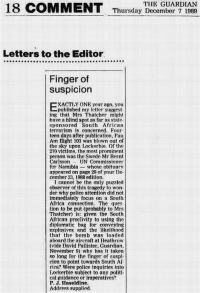
Using this information, which had not been reported elsewhere in the media, Haseldine wrote a letter to The Guardian on December 7, 1989:[6]
- Finger of suspicion
- "Exactly one year ago, you published my letter suggesting that Mrs Thatcher might have a blind spot as far as South African terrorism is concerned.
- "Fourteen days after publication, Pan Am Flight 103 was blown out of the sky upon Lockerbie. Of the 270 victims, the most prominent person was the Swede Mr Bernt Carlsson – UN Commissioner for Namibia – whose obituary appeared on page 29 of your December 23, 1988 edition.
- "I cannot be the only puzzled observer of this tragedy to wonder why police attention did not immediately focus on a South African connection. The question to be put (probably to Mrs Thatcher) is: given the South African proclivity to using the diplomatic bag for conveying explosives and the likelihood that the bomb was loaded aboard the aircraft at Heathrow (vide David Pallister, The Guardian, November 9, 1989) why has it taken so long for the finger of suspicion to point towards South Africa?
- "Were police inquiries into Lockerbie subject to any political guidance or imperatives?"
- P J Haseldine
- (Address supplied)
Carlsson's "secret meeting"
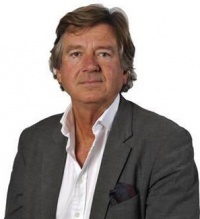
Jan-Olof Bengtsson is the political editor of Kvällsposten newspaper in Malmö, Sweden, and a renowned investigative journalist. Mr Bengtsson's most important work - although perhaps the least publicised - is his series of three articles in Sweden's iDAG newspaper on 12, 13 and 14 March 1990. Never published in the English language, the iDAG articles featured Sweden's UN Commissioner for Namibia Bernt Carlsson who was the most prominent victim of Pan Am Flight 103 which was sabotaged over Lockerbie, Scotland on 21 December 1988. Bengtsson alleged that Commissioner Carlsson's arm had been twisted by the diamond mining giant De Beers into making a stopover in London for a secret meeting and into joining the doomed flight, rather than taking as he had intended a Sabena flight direct from Brussels to New York:[7]
- "Bernt Carlsson, UN Commissioner for Namibia, had less than seven hours to live when at 11.06am on 21 December 1988 he arrived in London on flight BA 391.
- "Strictly speaking he was meant to fly directly from Brussels to New York in time for the historic signing of the Namibia Independence Agreement the day after. But Bernt Carlsson could not make it. He had a meeting. An important meeting with a 'pressuriser' from the South African diamond cartel, which was so secret that evidently not even Javier Pérez de Cuéllar, UN Secretary-General, knew anything about it. Here iDAG maps out the last 24 hours in the life of Bernt Carlsson.
- "The memorial service in the Folkets Hus in Stockholm on 11 January 1989 for Bernt Carlsson gathered most of our Heads of Government, representatives of the Namibia independence movement SWAPO and Javier Pérez de Cuéllar, the UN Secretary-General.
- "When he died in the Pan Am bombing, Bernt Carlsson was less than 24 hours away from the fulfilment of his dreams - the signing of the Namibia agreement in New York which would finally pave the way to a free and independent Namibia. This was supposed to be the climax of his career with the UN, a career that began in December 1986 when he was appointed Commissioner for Namibia. Bernt Carlsson had great support from SWAPO but much less so from South Africa because of that country's substantial economic interests in Namibia: an interest in gold, uranium but above all in diamonds.
- "Javier Pérez de Cuéllar in his speech at the memorial ceremony on a cold day in January last year [1989] described the last 24 hours in the life of Bernt Carlsson:
- 'Bernt Carlsson was returning to New York following an official visit to Brussels where he had spoken to a Committee within the European Parliament about the Namibia agreement,' Pérez de Cuéllar began. 'He stopped briefly in London to honour a long-standing invitation by a non-governmental organisation with interests in Namibia.'
- "Pérez de Cuéllar was wrong. True, Bernt Carlsson's trip to Brussels had been planned almost six months earlier. But his decision to return to New York via London was only made on 16 December 1988. The meeting in London was definitely not a long-standing invitation by Namibia sympathisers."
Lockerbie cover-up
Within a few weeks of those December 1988 newspaper reports, Bernt Carlsson's name would hardly ever be mentioned again by the mainstream media in the Lockerbie context. Bernt Carlsson had effectively become a "nonperson" - whose death was never properly investigated - and the Lockerbie cover-up was beginning:[8]
Nelson Mandela accused
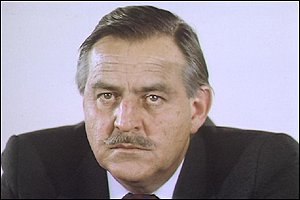
Three weeks after the Lockerbie disaster, the apartheid regime accused Nelson Mandela and the ANC of masterminding the sabotage of Pan Am Flight 103. This amazing accusation was made on 11 January 1989 by South African Foreign Minister Pik Botha who had travelled to Stockholm in Sweden with other foreign dignitaries – including UN Secretary-General Javier Pérez de Cuéllar – to attend the memorial service of United Nations Commissioner for Namibia, Bernt Carlsson, the highest profile victim of the 270 fatalities at Lockerbie.[9] Interviewed by Sue MacGregor on BBC Radio 4’s Today Programme, Pik Botha alleged that he and a 22-strong South African delegation, who were booked to fly from London to New York on 21 December 1988, had been targeted by the ANC. However, having been alerted to these ANC plans to kill him, Pik Botha said he managed to outsmart them by taking the earlier Pan Am Flight 101 from Heathrow to JFK, New York.[10] Pik Botha's claim to have been booked to travel on Pan Am Flight 103 was later shown to be false.[11]
President Botha quits
On 18 January 1989, President P W Botha was reported to have suffered a mild stroke which prevented him from attending a meeting with Namibian political leaders on 20 January 1989.[12] On 2 February 1989, P W Botha resigned as leader of the National Party (NP) anticipating his nominee – finance minister Barend du Plessis – would succeed him. Instead, the NP's parliamentary caucus selected as leader education minister F W de Klerk, who moved quickly to consolidate his position within the party. In March 1989, the NP elected de Klerk as state president but Botha refused to resign, saying in a television address that the constitution entitled him to remain in office until March 1990 and that he was even considering running for another five-year term. Following a series of acrimonious meetings in Cape Town, and five days after UN Security Council Resolution 435 was implemented in Namibia on 1 April 1989, Botha and de Klerk reached a compromise: Botha would retire after the parliamentary elections in September, allowing de Klerk to take over as president. However, P W Botha resigned from the state presidency abruptly on 14 August 1989 complaining that he had not been consulted by de Klerk over his scheduled visit to see president Kenneth Kaunda of Zambia: "The ANC is enjoying the protection of president Kaunda and is planning insurgency activities against South Africa from Lusaka," Botha declared on nationwide television. He said he had asked the cabinet what reason he should give the public for abruptly leaving office. "They replied I could use my health as an excuse. To this, I replied that I am not prepared to leave on a lie. It is evident to me that after all these years of my best efforts for the National Party and for the government of this country, as well as the security of our country, I am being ignored by ministers serving in my cabinet."[13]
President Bush says 'cool it'
According to British investigative journalist Paul Foot: "In mid-March 1989, three months after Lockerbie, US President George Bush rang Margaret Thatcher to warn her to 'cool it' on the subject."[14]
Thatcher visits Namibia
At the end of March 1989, Margaret Thatcher and the rising star in Conservative Research Department, David Cameron, visited apartheid South Africa.[15] The past and future British Prime Ministers made a point of visiting the Rössing Uranium Mine in Namibia (illegally occupied by apartheid South Africa in defiance of UN Security Council Resolution 435). In 1989, the Rössing mine was jointly owned by Rio Tinto Group and the Iranian Government, and was supplying uranium to develop Iran’s nuclear programme. Mrs Thatcher was so impressed with the Rössing Uranium Mine that she declared it made her "proud to be British", a sentiment echoed by David Cameron.[16]
Pressure on UN's man
Extract from Patrick Haseldine's letter to The Guardian of August 5, 1991:
- "On April 1, 1989 Mrs Thatcher put pressure on UN Special Representative in Namibia, Martti Ahtisaari, to permit the South African Defence Force (SADF) to take action against SWAPO soldiers who were peacefully returning to Namibia to vote in the 1989 independence elections. As a result, as many as 308 SWAPO soldiers were killed - shot in the back according to former SADF major Nico Basson.
- "Whether Mrs Thatcher could have persuaded UN Commissioner for Namibia, Bernt Carlsson, to agree to such treachery we shall never know since Mr Carlsson was assassinated four months earlier, on December 21, 1988.
- "It may not be entirely coincidental that on the same day (July 25, 1991) as South Africa's Foreign Minister, Pik Botha, admitted the illicit funding of anti-SWAPO political parties in Namibia, BBC Radio Four's Today Programme carried an interview about the Scottish police investigation into the Lockerbie disaster, in which Mr Carlsson perished. According to the interview, the criminal investigation has just been concluded and we are now asked to believe that Libyan intelligence were responsible.
- "In the light of Major Basson's evidence (detailed by Phillip van Niekerk's article, Guardian, July 27) and Pik Botha's admission, I think that, even at this late stage, the Scottish police should reopen their investigation and look for a South African connection to the Lockerbie tragedy.[17]
Secret nuclear deal
It has recently been reported that Margaret Thatcher and David Cameron concluded a secret nuclear deal with the apartheid regime during their visit to South Africa in 1989.[18]
Blackout over Lockerbie
For the past 20 years, Professor Robert Black has been suppressing the truth about the Lockerbie disaster, thus delaying justice for the 270 victims of Pan Am Flight 103 and their relatives. It is high time that this "Blackout over Lockerbie" was illuminated and dispelled.[19]
Prof Black was supported in his attempt to blackout apartheid South Africa’s targeting of Bernt Carlsson on Pan Am Flight 103 by inter alia these assets of British intelligence:[20]
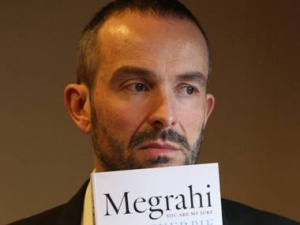
- John Ashton (Author, producer and researcher, see: The Maltese Double Cross[21]; the 2001 book "Cover-up of Convenience" by John Ashton and Ian Ferguson[22]; the 2012 book "Megrahi; You are my Jury" by John Ashton[23]; and the 2012 article "Was Libya really behind it?" with John Ashton[24].)
- Ian Ferguson (Author, journalist and researcher, see: The Lockerbie Trial.com website of Prof Black and Ian Ferguson; and the 2009 film Lockerbie Revisited researcher Ian Ferguson[25].)
- Robert Forrester (Secretary of Justice for Megrahi campaign group[26].)
- Professor Andrew Fulton, (see: "David Cameron appoints Andrew Fulton chairman of Scottish Conservative Party"; and [27].)
- Dr Alan George (Middle East academic, recruited by solicitors Eversheds to reinforce the defence of Megrahi's co-accused Lamin Khalifah Fhimah[28].)
- Dr Morag Kerr (Deputy Secretary of Justice for Megrahi campaign group, see [29].)
- Adam Larson (Associate of Dr Kerr and owner of The Lockerbie Divide website[30].)
- Steven Raeburn (Editor of Scots Law journal The Firm[31].)
Social democrat
A native of Stockholm, Bernt Carlsson joined the Swedish Social Democratic Youth League when he was sixteen, studied economics at Stockholm University and, upon graduation, went into Sweden's foreign ministry. He worked as assistant to the Minister of Commerce in 1967 and, three years later, was assigned to be international secretary of the ruling Social Democratic Party of Sweden in 1970. Concurrent with his position in the party, Prime Minister, Olof Palme, appointed him as Special Adviser.
Socialist International
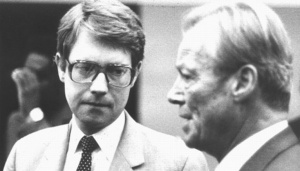
In 1976, Bernt Carlsson became Secretary-General of Socialist International (SI), based in London, at the same time as former Federal German Chancellor, Willy Brandt, assumed the SI presidency. For the next seven years, Carlsson was engaged in extending the SI's influence beyond Europe to Third World countries, channelling money and political support to the struggle for liberation in Southern Africa. Carlsson also pioneered moves towards Middle East peace using the SI's unique position of having Israel's governing Labour Party as a member, and at the same time retaining very good ties with Arab countries and Yasser Arafat's faction in the PLO. Bernt Carlsson developed a particularly close relationship with Arafat's right-hand man, Issam Sartawi, who was murdered (allegedly by the Abu Nidal Organisation) during an SI conference in Portugal on 10 April 1983.
Burgled in London
In a 1989 tribute, Robin Sears, Canadian Deputy Secretary-General of Socialist International, wrote about the pressure put on Bernt Carlsson by apartheid South African "bastards":[32]
"Others have paid more formal homage to his important political and diplomatic achievements. But as a fascinating and complex human being he was little known. These thoughts are an attempt to reveal some of the joys of knowing Bernt Carlsson. We stood on the beach outside the Tel Aviv Hilton watching the teenagers at play, having just returned by helicopter from the devastated battle zones in Lebanon. More in wonder than in anger he said, 'How can they be so unaffected by the horrors. It's only a few minutes from here.' The contradictions of political life didn't sit easily with him. Bernt had just come back from overseeing the despatch to burial in another country of his friend Issam Sartawi — assassinated the day before — ashen and grey with grief and anger. 'And they will never pay...', He muttered. Sitting in the umpteenth airport departure lounge that month, Bernt whispered breathlessly about the break-in at the squalid little apartment in London he rarely saw. 'They messed things up and pawed through my papers. Then just to make sure I knew it wasn't a simple burglary they piled my money in the centre of the living-room rug.' South African goons were active in London at the time, and some had a bizarre sense of humour. 'But don't talk about it, and I'm not going to report it. That would just give the bastards their little victory'."
Bust-up with Brandt
Earlier in 1983, however, in a dispute about what he perceived as the SI president's authoritarian approach, Bernt Carlsson rebuked Willy Brandt saying:
"This is a Socialist International — not a German International."
Following the April 1983 SI congress in Albufeira, Portugal, to where Brandt had contentiously decided to relocate from Sydney — on account of the protests of newly-elected pro-Israeli Australian Prime Minister Bob Hawke against the PLO's inclusion — Brandt retaliated by forcing Carlsson to step down.[33]
Swedish diplomat
Bernt Carlsson left London and returned to Sweden in 1983 and, for two years, became Olof Palme's special emissary to the Middle East and Africa. Palme entrusted him with an important Middle East role in delicate attempts to negotiate a peace agreement between Iran and Iraq. From 1985 to 1987 Carlsson was head of Nordic Affairs in Sweden's foreign ministry. On 28 February 1986, Olof Palme was assassinated.
UN Commissioner for Namibia
On July 1, 1987 Bernt Carlsson was appointed an Assistant-Secretary-General of the United Nations and the UN Commissioner for Namibia. A year later, he convened a meeting in Stockholm between the SWAPO leadership (Sam Nujoma, Hage Geingob and Hidipo Hamutenya), and a delegation of "whites" from Namibia to discuss developments in the independence process.
Namibia's independence had been expected to take place soon after United Nations Security Council Resolution 435 was agreed in September 1978. However, it took over 10 years for UNSCR 435 to be implemented. The delay was blamed by author and journalist Christopher Hitchens on Chester Crocker's 'procrastination' and on President Ronald Reagan's 'attempt to change the subject to the presence of Cuban forces in Angola' as well as the 'flagrant bias' in America's Namibia policy in favour of apartheid South Africa. Hitchens praised Carlsson's role as a 'neutral mediator' in the process leading to Namibia's independence:[34]
"An important participant was Bernt Carlsson, UN Commissioner for Namibia, who worked tirelessly for free elections in the colony and tried to isolate the racists diplomatically. Carlsson had been Secretary-General of the Socialist International, and International Secretary of the Swedish Social Democratic Party. He performed innumerable services for movements and individuals from Eastern Europe to Latin America. His death in the mass murder of the passengers on Pan American Flight 103 just before Christmas 1988, and just before the signing of the Namibia accords in New York, is appalling beyond words."
An editorial in The Guardian of December 23, 1988 stated:
"Two days before Christmas, two tides flow strongly. One - the greater tide - is the tide of peace. More nagging, bloody conflicts have been settled in 1988 than in any year since the end of the Second World War. There are forces for good abroad in the world as seldom before. There is also a tide of evil, a force of destruction. By just one of those ironies which afflict the human condition, peace came to Namibia yesterday. Meanwhile, on a Scottish hillside, the body of the Swedish UN Commissioner for Namibia was one amongst hundreds strewn across square miles of debris: a victim - supposition, but strongly based - of a random terrorist bomb which had blown a 747 to bits at 31,000 feet."[35]
Ten years were to elapse until the Ronald Reagan/Mikhail Gorbachev summit of the leaders of the United States and the Soviet Union in Moscow (May 29, 1988 – June 1, 1988), finally secured the implementation of UNSCR 435, which would require South Africa to relinquish its control of Namibia.[36]
Assassinated on Pan Am Flight 103
Of the 270 people murdered at Lockerbie on 21 December 1988, Assistant-Secretary-General of the United Nations and UN Commissioner for Namibia, Bernt Carlsson, was obviously a target. Yet the Lockerbie investigators (CIA, FBI and the Scottish Police) failed to undertake even the most cursory of investigations into Bernt Carlsson's murder.
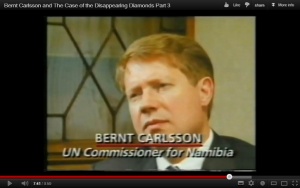
Commissioner Carlsson was to have taken charge of Namibia on 22 December 1988 immediately after apartheid South Africa had signed an agreement at UN headquarters giving up its illegal occupation of the country. In a 29 September 1987 TV interview, Bernt Carlsson had warned that he intended to start proceedings against the countries and firms which had been defying UN law over many years by stealing billions of pounds-worth of Namibia's natural resources. Among those facing UN compensation claims were: the diamond mining firm De Beers; the apartheid regime of South Africa; Rio Tinto Group, owners of the Rössing Uranium Mine; and, the government of Iran which today still owns 15% of Rössing and, in 1988-89, received large shipments of uranium from Namibia.[37]
Because Bernt Carlsson died at Lockerbie, none of these prosecutions ever took place. Now, more than 21 years after the Lockerbie disaster, it is probably too late to seek compensation from the offending countries and firms. However, the lapse of time cannot allow the murder of a senior UN diplomat to go unpunished.
On 20 May 2012, the so-called "Lockerbie bomber" Abdelbaset Ali Mohmed Al Megrahi, who is innocent of the crime, finally succumbed to cancer. The UN must now establish a Commission of Inquiry to investigate the crime of Lockerbie, and authorise the Commission to refer the case to the International Court of Justice for action to be taken against both the individuals and country or countries involved in the targeting of Bernt Carlsson on Pan Am Flight 103.[38]
Call for urgent inquiry
In September 2009, former Labour MEP Michael McGowan called for an urgent independent inquiry led by the United Nations into the Lockerbie disaster. McGowan wrote that he was personally affected by the crash:
- "As President of the Development Committee of the European Parliament, I had invited Bernt Carlsson, the Assistant Secretary-General of the United Nations and UN Commissioner for Namibia, to call in at Brussels in December 1988. He was on his way back to the United States from Namibia and agreed to address members of the Development Committee, which he did. In Brussels, he spoke about his hopes for an independent Namibia and the end of apartheid in South Africa to a packed meeting of MEPs.
- "And afterwards he confirmed his acceptance to visit Leeds the following year to give the 1989 Peace Lecture in honour of Olof Palme, the former Swedish Prime Minister, who was murdered in Stockholm on February 28, 1986. He said how much he was looking forward to coming to Leeds to pay tribute to his fellow Swede with whom he had worked closely as international secretary of the Social Democratic Party of Sweden, and also as a special adviser to Palme. Bernt Carlsson did not make that visit to Leeds in 1989. He was a passenger on Pan Am Flight 103 and he died when the plane was blown up over Lockerbie on December 21, 1988. He was a giant of diplomacy, gentle, quiet, but a tough negotiator. His death, like that of his friend and fellow Swede, Prime Minister Palme, who was murdered in the street in Stockholm returning with his wife from a night at the cinema, was the result of a terrorist act and remains a mystery.
- "A call by the British Government for an independent inquiry led by the United Nations to find out the truth about Pan Am Flight 103 is urgently required. We owe it to the families of the victims of Lockerbie and the international community to identify those responsible. That Bernt Carlsson was on that plane should be an extra incentive for the UN to take action in view of the fact that this impressive diplomat was dealing with some of the most sensitive and violent situations being perpetrated by the brutal apartheid regime in both South Africa and Namibia, besides his work in the Middle East. The best tribute to the lives and families of the 270 victims of Lockerbie, including Bernt Carlsson, and the most positive action for the international community to take against terrorism, is to launch an independent inquiry into this gross act of mass murder. Nothing less will suffice."[39]
UN murder inquiry
Echoing Michael McGowan's demand for an inquiry, and following publication of his article, a commentator's e-petition in the Yorkshire Post asked prime minister Gordon Brown "to endorse calls for a United Nations Inquiry into the murder of UN Commissioner for Namibia, Bernt Carlsson, in the 1988 Lockerbie bombing." The petition continued:
- "Sweden's UN Commissioner for Namibia, Bernt Carlsson, was the most prominent of the 270 Lockerbie bombing victims murdered on 21 December 1988. In investigating Carlsson's murder, Scottish police detective John Crawford stated in his book (The Lockerbie Incident: A Detective's Tale): 'We even went as far as consulting a very helpful lady librarian in Newcastle who contacted us with information she had on Bernt Carlsson. She provided much of the background on the political moves made by Carlsson on behalf of the United Nations. He had survived a previous attack on an aircraft he had been travelling on in Africa.
- "It is unlikely that he was a target as the political scene in Southern Africa was moving inexorably towards its present state....I discounted the theory as being almost totally beyond the realms of feasibility."[40]
The petition concluded:
- "A United Nations Inquiry can be expected to find a different - and much better - explanation for Bernt Carlsson's murder."[41]
Memorials
In 2008, to mark the 20th anniversary of the sabotage of Pan Am Flight 103, the Socialist International published an article entitled "Remembering Bernt Carlsson". The article quoted from the eulogy given by Sten Andersson (then Sweden's foreign minister) at the January 1989 memorial service in Stockholm. Andersson described Carlsson as:
- "A man with a natural talent for the difficult art of silent diplomacy. In that art many are unsuccessful. But not Bernt. For Bernt was also a man 'with a soul as tough as steel' as his friend Michael Harrington so nicely put it.
- "We, his friends and colleagues, know that he was knowledgeable, with analytical acumen, single-minded and, most important of all, untiring in his fight for those most exposed, those most persecuted. At all times and in every post Bernt was always prepared in concrete action to make common cause with the weak and oppressed. In our country and the world."[42]
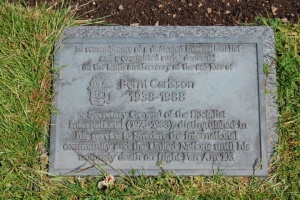
Memorial plaque dedicated to the most prominent of the 270 people killed at Lockerbie on 21 December 1988: Assistant-Secretary-General of the United Nations and UN Commissioner for Namibia, Bernt Carlsson. The inscription reads:
- "In remembrance of a dedicated internationalist and a committed social democrat on the tenth anniversary of the sad loss of Bernt Carlsson (1938-1988), Secretary-General of the Socialist International (1976-1983), distinguished in his service to Sweden, the international community and the United Nations until his untimely death on flight Pan Am 103."[43]
The Bernt Carlsson Trust – otherwise known as One World Action – was founded by Glenys Kinnock on December 21, 1989 (the first anniversary of the Lockerbie air disaster) in memory of Carlsson.[44]
In Windhoek, Namibia, a street in the Pionierpark Extension 1 township is named "Bernt Carlsson Road".
References
- ↑ "Bernt Carlsson: Assassinated on Pan Am Flight 103"
- ↑ Dukakis Backers Agree Platform Will Call South Africa 'Terrorist'
- ↑ "U.N. Officer on Flight 103" The New York Times December 22, 1988
- ↑ ["Bernt Carlsson's Obituary"] The Guardian December 23, 1988
- ↑ Michael Harrington (1988-12-26). "Lost On Flight 103: A Hero To The Wretched Of The World". Los Angeles Times. Retrieved 2009-02-26.Page Module:Citation/CS1/styles.css must have content model "Sanitized CSS" for TemplateStyles (current model is "Scribunto").
- ↑ "Finger of suspicion" The Guardian December 7, 1989
- ↑ "Bernt Carlsson in a secret meeting with 'pressuriser' from the Diamond Cartel"
- ↑ "Lockerbie Cover-Upper Ian Ferguson"
- ↑ "Lockerbie: Bernt Carlsson's secret meeting in London"
- ↑ "ANC as the fall-guys for Lockerbie bombing" Patrick Haseldine's letter to The Guardian, 22 April 1992
- ↑ "Why the Lockerbie flight booking subterfuge, Mr Botha?"
- ↑ The New York Times 22 January 1989 "Botha suffers mild stroke"
- ↑ Botha Quits, Criticizes Successor
- ↑ "Lockerbie: CIA 'fitted up' Gaddafi at the UN Security Council"
- ↑ "Cameron's freebie to apartheid South Africa"
- ↑ "Rössing Uranium Mine"
- ↑ "Missing diplomatic links and the Lockerbie tragedy"
- ↑ "How the US and UK 'lost' three nuclear weapons"
- ↑ "Blackout over Lockerbie"
- ↑ "Blackout of Mandela Blueprint for Lockerbie Justice"
- ↑ "Commentary on The Maltese Double Cross"
- ↑ "Cover-up of Convenience"
- ↑ "Megrahi: You are my Jury"
- ↑ "Was Libya really behind it?"
- ↑ "Lockerbie Revisited"
- ↑ "Robert Forrester Facebook page"
- ↑ "Former MI6 spy joins Armor Group to hunt down new business"
- ↑ "Alan George libel case
- ↑ "Dr Morag Kerr should drop all this cloak and dagger 'Rolfe' nonsense"
- ↑ "The Lockerbie Divide"
- ↑ "The Firm"
- ↑ Robin V. Sears (1989). "Bernt Carlsson: A Very Private Public Servant" (PDF). Development Dialogue (Dag Hammarskjöld Foundation) (1989:1): 82–88.Page Module:Citation/CS1/styles.css must have content model "Sanitized CSS" for TemplateStyles (current model is "Scribunto").
- ↑ "Never at a Loss for Words". TIME. 1983-04-18. Retrieved 2008-07-09.Page Module:Citation/CS1/styles.css must have content model "Sanitized CSS" for TemplateStyles (current model is "Scribunto").
- ↑ Hitchens, Christopher (1993). For the sake of Argument: Essays and Minority Reports. Verso. p. 99. ISBN 0-86-091435-6.Page Module:Citation/CS1/styles.css must have content model "Sanitized CSS" for TemplateStyles (current model is "Scribunto").
- ↑ "One view from a desolate hillside"
- ↑ "Namibia's independence process 1988-1990"
- ↑ "Bernt Carlsson laying down the law about Namibia"
- ↑ "Bernt Carlsson: Assassinated on Pan Am Flight 103"
- ↑
{{URL|example.com|optional display text}} - ↑ John Crawford (2002). "The Lockerbie Incident: A Detective's Tale". pp. 88–89. Retrieved 2009-10-04.Page Module:Citation/CS1/styles.css must have content model "Sanitized CSS" for TemplateStyles (current model is "Scribunto").
- ↑ http://webarchive.nationalarchives.gov.uk/20110412161239/http://petitions.number10.gov.uk/BerntCarlsson/ "Petition to PM Gordon Brown for a United Nations Inquiry into Bernt Carlsson's murder"
- ↑ "Remembering Bernt Carlsson". Socialist International. Retrieved 2009-02-02.Page Module:Citation/CS1/styles.css must have content model "Sanitized CSS" for TemplateStyles (current model is "Scribunto").
- ↑ [Photo by George DeBaly, June 2009, in the Garden of Remembrance at the Lockerbie Air Disaster Memorial in Dryfesdale Cemetery.]
- ↑ "One World Action"
See also
External links
- Countdown to PA 103
- Lost on Flight 103: A Hero to the Wretched of the World
- Namibia's long journey to independence
- Bernt Carlsson Trust
- Socialist International website
Wikipedia is not affiliated with Wikispooks. Original page source here
